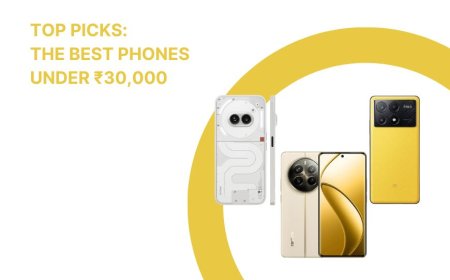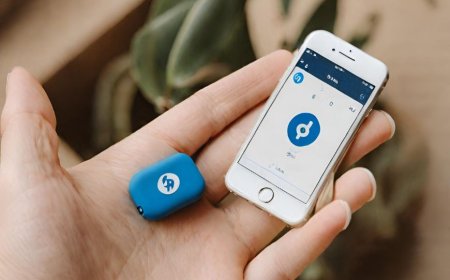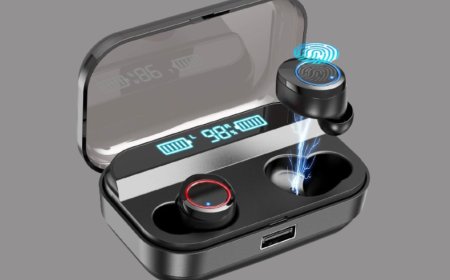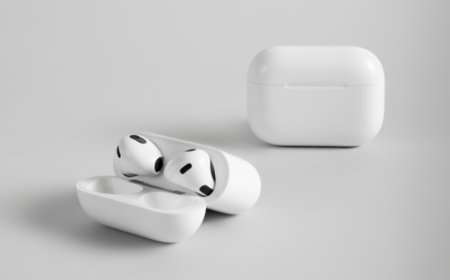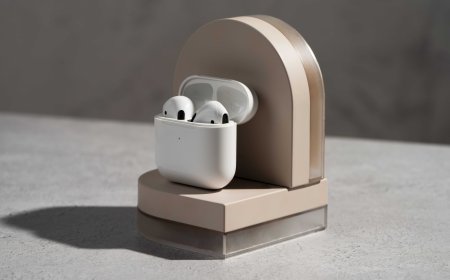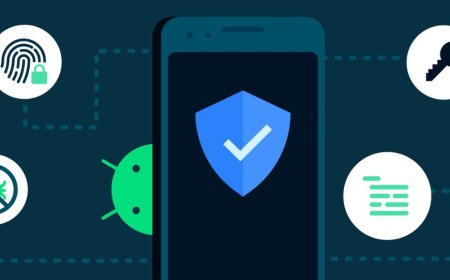Maximizing Battery Life on Wireless Earbuds
Unlock the secret to longer battery life on wireless earbuds with Tectoks. Experience the best audio performance without worrying about charging
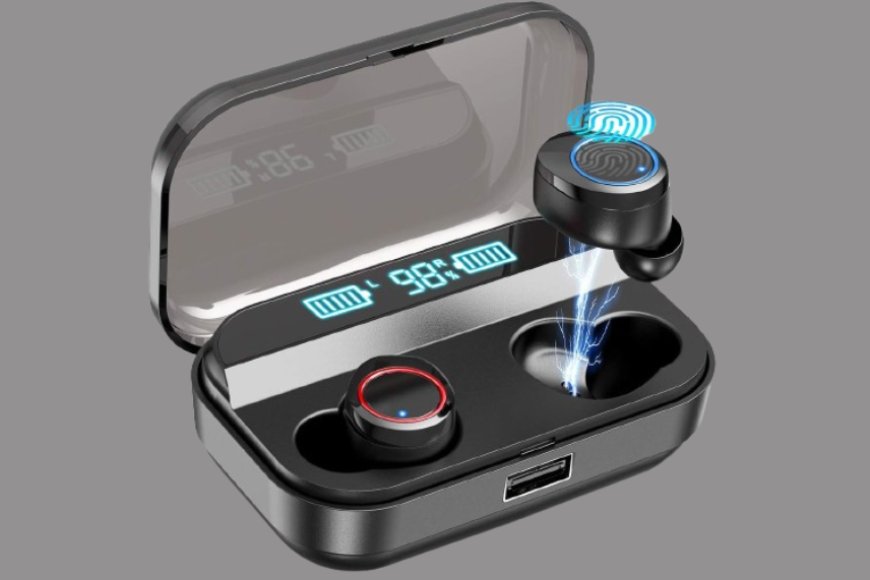
Table of Contents:
-
Introduction
-
How to extend earbud battery life
-
Wireless earbuds features and performance
-
Best practices for wireless earbuds
-
Conclusion
1. Introduction
Wireless earbuds are becoming more popular than ever, thanks to their convenience, comfort, and features. But what are the benefits of wireless earbuds, and why is battery life important? In this blog post, we will explore these questions and provide some statistics and facts about wireless earbuds’ battery life. We will also preview the main points of the blog post, which are:
-
How wireless earbuds work and how they differ from wired headphones
-
The advantages of wireless earbuds, such as better sound quality, noise cancellation, touch control, voice assistant, and water resistance
-
The challenges of wireless earbuds, such as audio compression, latency, and connectivity issues,
-
The importance of battery life and how to extend it
-
The best wireless earbuds in the market, based on battery life, sound quality, features, and price
By the end of this blog post, you will have a better understanding of wireless earbuds and how to choose the best ones for your needs. Let’s get started!
2. How to extend earbud battery life
Wireless earbuds use batteries to power their Bluetooth connection, audio drivers, and other features.
The battery life of wireless earbuds depends on several factors, such as:
-
Volume: The higher the volume, the more power the earbuds consume to produce sound. Lowering the volume can save battery life and protect your hearing.
-
Bluetooth connection: The earbuds need to maintain a stable Bluetooth connection with your device, which consumes power. The distance and interference between the earbuds and the device can affect the connection quality and battery life. Keeping the device close to the earbuds and avoiding obstacles can improve the connection and save battery life.
-
Ambient noise: The earbuds need to overcome ambient noise to deliver clear sound to your ears. The more noise there is, the more power the earbuds need to use. Using noise-canceling features can help reduce the ambient noise and the volume needed, but they also consume battery power. You can turn off noise-canceling features when you don’t need them to save battery life.
-
Features: The earbuds may have other features that consume battery power, such as touch controls, voice assistants, LED lights, etc. You can turn off these features when you don’t need them to save battery life.
Some tips and tricks to optimize these factors and extend battery life are:
-
Lower the volume: You can lower the volume to a comfortable level that allows you to hear the sound clearly without damaging your ears or draining your battery.
-
Turn off Bluetooth when not in use. You can turn off the Bluetooth connection on your device or the earbuds when you are not using them to save battery life. You can also use the earbuds in mono mode, which means using only one earbud at a time, to save battery life.
-
Use noise-canceling features wisely: You can use noise-canceling features when you need to block out ambient noise, such as in a noisy environment or when you want to focus. You can turn off noise-canceling features when you don’t need them, such as in a quiet environment or when you want to be aware of your surroundings.
-
Charge sensibly: You can charge your earbuds and the charging case regularly to avoid running out of power. You can also avoid overcharging or undercharging your earbuds and the charging case, as this can damage the battery and reduce its lifespan. You can follow the manufacturer’s instructions on how to charge your earbuds and the charging case properly.
-
Store properly: You can store your earbuds and the charging case in a cool, dry, and clean place to avoid exposing them to extreme temperatures, moisture, dust, or dirt, which can damage the battery and the earbuds.
Some examples of wireless earbud models that have long battery life or fast charging capabilities are:
-
Master & Dynamic MW08: These earbuds offer up to 12 hours of battery life on a single charge and 42 hours with the charging case. They also support wireless charging and fast charging, which can give 50% battery life in 15 minutes and a full battery life in 45 minutes.
-
Lypertek PurePlay Z3 2.0: These earbuds offer up to 10 hours of battery life on a single charge and 80 hours with the charging case. They also support fast charging, which can give you 2 hours of playtime in 15 minutes.
-
Edifier TWS1 PRO: These earbuds offer up to 12 hours of battery life on a single charge and 42 hours with the charging case. They also support fast charging, which can give you 2 hours of playtime in 15 minutes.
-
Back Bay Duet 50 Pro: These earbuds offer up to 8 hours of battery life on a single charge and 130 hours with the charging case. They also support fast charging, which can give you 1 hour of playtime in 15 minutes.
-
JBL Reflect Flow: These earbuds offer up to 10 hours of battery life on a single charge and 30 hours with the charging case. They also support fast charging, which can give you 1 hour of playtime in 10 minutes.
-
Cambridge Audio Melomania 1+: These earbuds offer up to 9 hours of battery life on a single charge and 45 hours with the charging case. They also support fast charging, which can give 1.5 hours of playtime in 15 minutes.
-
Edifier NB2 Pro: These earbuds offer up to 9 hours of battery life on a single charge and 32 hours with the charging case. They also support fast charging, which can give you 2 hours of playtime in 15 minutes.
-
Beats Powerbeats 4 Wireless: These earbuds offer up to 15 hours of battery life on a single charge and no charging case. They also support fast charging, which can give you 2 hours of playtime in 5 minutes.
I hope this helps you understand how to extend earbud battery life and some of the best wireless earbud models that offer long battery life or fast charging capabilities.
3. Wireless earbuds features and performance
Wireless earbuds have various features and performance aspects that can enhance your listening experience, but they can also affect the battery life of the earbuds.
Some of the common features and performance factors are:
-
Sound quality: The sound quality of wireless earbuds depends on the audio drivers, the codecs, the equalizer settings, and the Bluetooth connection. The higher the sound quality, the more power the earbuds need to process and transmit the audio signal. For example, high-resolution audio codecs like LDAC or aptX HD can deliver better sound quality than standard SBC or AAC codecs, but they also consume more battery power.
-
Microphone: The microphone of wireless earbuds is used for voice calls, voice assistants, and noise-canceling features. The microphone quality depends on the number, placement, and sensitivity of the microphones, as well as the noise reduction and beamforming technologies. The better the microphone quality, the more power the earbuds need to capture and filter the voice signal. For example, some earbuds have multiple microphones on each earbud to improve voice clarity and noise-canceling performance, but they also drain the battery faster.
-
Touch controls: The touch controls of wireless earbuds are used for adjusting the volume, changing the tracks, activating the voice assistant, and managing the calls. The touch controls depend on the sensors, the gestures, and the feedback mechanisms of the earbuds. The more advanced the touch controls, the more power the earbuds need to detect and respond to the touch inputs. For example, some earbuds have capacitive touch sensors that can recognize different gestures and provide haptic or audible feedback, but they also use more battery power.
Some recommendations for wireless earbud features and performance that balance battery life and user experience are:
-
Sound quality: You can choose wireless earbuds that support high-resolution audio codecs, but you also have the option to switch to lower-quality codecs when you need to save battery life. You can also adjust the equalizer settings to suit your preferences and the type of music you listen to without affecting the battery life too much.
-
Microphone: You can choose wireless earbuds that have good microphone quality but also have the option to turn off the noise-canceling or voice assistant features when you don’t need them. You can also use the earbuds in mono mode, which means using only one earbud at a time, to save battery life and improve the microphone performance.
-
Touch controls: You can choose wireless earbuds that have intuitive and responsive touch controls, but you also have the option to customize them or disable them when you don’t need them. You can also use the physical buttons or the app on your device to control the earbuds instead of relying on the touch controls all the time.
Some examples of wireless earbud models that have good features and performance without compromising battery life are:
-
Sony WF-1000XM5: These earbuds offer excellent sound quality, microphone quality, and touch controls, as well as adaptive noise-canceling and voice assistant features. They also have a long battery life of up to 8 hours on a single charge and 24 hours with the charging case. They support high-resolution audio codecs like LDAC and aptX HD and have customizable equalizer settings and touch controls.
-
Apple AirPods Pro 2: These earbuds offer great sound quality, microphone quality, and touch controls, as well as active noise-canceling and voice assistant features. They also have a decent battery life of up to 5 hours on a single charge and 24 hours with the charging case. They support the AAC codec, which is compatible with most Apple devices, and have adaptive equalizer settings and touch controls.
-
Bose QuietComfort Ultra Earbuds: These earbuds offer superb sound quality, microphone quality, and touch controls, as well as adjustable noise-canceling and voice assistant features. They also have a good battery life of up to 6 hours on a single charge and 18 hours with the charging case. They support the SBC and AAC codecs and have customizable equalizer settings and touch controls.
I hope this helps you understand wireless earbud features and performance and some of the best wireless earbud models that offer good features and performance without compromising battery life.
4. Best practices for wireless earbuds
Wireless earbuds are convenient and versatile devices that can enhance your listening experience, but they also require proper maintenance and care to ensure their longevity and performance.
Here are some tips and recommendations for wireless earbud maintenance and care, usage, and accessories:
-
Maintenance and care: Wireless earbuds need to be cleaned regularly to remove dirt, dust, wax, and debris that can clog the speaker or microphone grilles, affect the sound quality, or cause infections. You should also store your earbuds in a dry and clean case when not in use to protect them from dust, moisture, and damage. Additionally, you should charge your earbuds and the charging case according to the manufacturer’s instructions and avoid overcharging or undercharging them, as this can damage the battery and reduce its lifespan.
-
Some of the tools and methods you can use to clean and care for your wireless earbuds are:
-
Use a soft-bristled brush or a small silicone pastry brush to gently brush away the dirt and dust from the grilles.
-
A lightly dampened microfiber cloth to wipe down the earbuds and the exterior of the case. Do not use any cleaning agents or water, and do not over-saturate the cloth.
-
A cotton bud dipped in 70% isopropyl alcohol (optional) to disinfect the earbuds and the charging points. Do not use rubbing alcohol, as it can remove color or break down leather or fabric faster.
-
Compressed air to blow away the dust and debris from the charging points and the grilles. Do not use too much pressure or too close to the earbuds, as this can damage the components.
-
Warm water and mild detergent (such as dish soap) to wash the ear tips, if they are detachable and made of silicone. Do not use running water or soap on the earbuds themselves, even if they are water-resistant.
-
A soft, lint-free cloth to dry the earbuds, the ear tips, and the case thoroughly before putting them back together or using them.
-
Usage: Wireless earbuds can provide a great listening experience, but they can also pose some risks if they are used improperly or excessively. You should be mindful of the volume, the duration, and the environment when using your wireless earbuds and follow some dos and don’ts, such as:
-
Do lower the volume to a comfortable level that allows you to hear the sound clearly without damaging your ears or draining your battery. A good rule of thumb is to listen at 60% of the maximum volume for no more than 60 minutes a day.
-
Do give your ears a rest by taking regular breaks to avoid ear fatigue and reduce the risk of long-term hearing loss. You can also use earbuds that fit comfortably in your ears and do not cause discomfort or irritation.
-
Use noise-canceling features wisely when you need to block out ambient noise, such as in a noisy environment or when you want to focus. You can turn off noise-canceling features when you don’t need them, such as in a quiet environment or when you want to be aware of your surroundings.
-
Turn off Bluetooth when not in use to save battery life and avoid interference. You can also use the earbuds in mono mode, which means using only one earbud at a time, to save battery life and improve the microphone performance.
-
Customize or disable the touch controls, if possible, to suit your preferences and avoid accidental inputs. You can also use the physical buttons or the app on your device to control the earbuds instead of relying on the touch controls all the time.
-
Don’t use your earbuds while driving or crossing roads, as they can block out surrounding sounds and make it dangerous. You should also be careful of the laws and regulations regarding earbud usage in your area, as some places may prohibit or limit their use while driving.
-
Don’t expose your earbuds to extreme temperatures, moisture, physical damage, or dirt, as they can damage the battery and the earbuds You should also avoid sharing your earbuds with others, as this can spread infections.
-
Accessories or cases: Wireless earbuds can benefit from some accessories or cases that can protect and enhance their battery life, sound quality, features, and comfort.
-
Some examples of wireless earbud accessories or cases are:
-
Silicone covers or skins can provide extra protection, grip, and style to your earbuds and their case. You can choose from various colors, patterns, and designs to suit your personality and preferences. Some silicone covers also have hooks or keychains that can help you carry or attach your earbuds to your bag, belt, or other items.
-
Ear tips or cushions can improve the fit, comfort, and sound isolation of your earbuds. You can choose from different sizes, shapes, and materials to find the best ear tips or cushions for your ears and your earbuds. Some ear tips or cushions also have sweat guards or water resistance features that can prevent moisture from entering earbuds.
-
Carrying cases or pouches that can store and protect your earbuds and their case when not in use. You can choose from hard or soft cases or pouches, depending on your preference and needs. Some carrying cases or pouches also have extra compartments or pockets that can hold your other accessories, such as cables, chargers, and adapters.
-
Wireless chargers or power banks that can charge your earbuds and their case without needing a cable or a plug. You can choose from various models and capacities, depending on your budget and needs. Some wireless chargers or power banks also have fast charging or wireless charging capabilities that can charge your earbuds and their case quickly and conveniently.
I hope this helps you understand the best practices for wireless earbuds and some of the best wireless earbud accessories or cases that can protect and enhance their battery life.
5. Conclusion
Wireless earbuds are amazing devices that can provide you with a convenient, comfortable, and enjoyable listening experience. However, they also require proper maintenance and care, as well as smart usage and choices, to ensure their longevity and performance. In this blog post, we have learned:
-
How wireless earbuds work and how they differ from wired headphones
-
The advantages of wireless earbuds, such as better sound quality, noise cancellation, touch control, voice assistant, and water resistance
-
The challenges of wireless earbuds, such as audio compression, latency, and connectivity issues,
-
The importance of battery life and how to extend it
-
The best wireless earbuds in the market, based on battery life, sound quality, features, and price
-
The best practices for wireless earbud maintenance and care, usage, and accessories
We hope this blog post has helped you understand wireless earbuds and how to choose the best ones for your needs. Wireless earbuds can offer you many benefits, but they also depend on battery life to function properly. By following the tips and recommendations we have shared, you can optimize your wireless earbuds’ battery life and enjoy them for longer.
If you have any feedback, questions, or suggestions, please feel free to leave a comment below or contact us via email. We would love to hear from you and help you with your wireless earbud needs. You can also check out our related blog posts for more information and reviews on wireless earbuds. Thank you for reading and happy listening!
What's Your Reaction?









